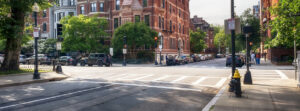 Driving, biking, or walking in Boston can be stressful. The city’s narrow streets, heavy traffic, and mix of cars, cyclists, and pedestrians make some intersections especially dangerous. Knowing where these problem areas are—and what steps to take if you’re ever hurt in a crash—can help keep you safe and protect your rights.
Driving, biking, or walking in Boston can be stressful. The city’s narrow streets, heavy traffic, and mix of cars, cyclists, and pedestrians make some intersections especially dangerous. Knowing where these problem areas are—and what steps to take if you’re ever hurt in a crash—can help keep you safe and protect your rights.
Boston’s Most Dangerous Intersections
While accidents can happen anywhere, certain intersections see more than their share of collisions. These are five of the most hazardous spots in Boston:
- Massachusetts Avenue & Melnea Cass Boulevard
This intersection has become notorious for accidents. From 2014 to 2024, more than 124 crashes occurred here, many involving pedestrians and cyclists. With so much activity in a small area, it’s one of Boston’s most dangerous places to cross. - Massachusetts Avenue & Huntington Avenue
Cyclists face particular risks here. Drivers turning across bike lanes have caused serious and even fatal “right hook” crashes. With heavy traffic and frequent turns, it’s a hot spot for collisions. - Brookline Avenue & Riverway (Longwood area)
The Longwood Medical Area is always congested, and this intersection has a history of serious accidents. Drivers making quick left turns and heavy pedestrian activity make it especially risky. - Columbus Avenue through Rutland Square
Cyclists describe this stretch as a “deathtrap.” Narrow lanes, potholes, and speeding cars create unsafe conditions for everyone on the road. - Cedar Street & Columbus Avenue (Roxbury)
Local residents report frequent crashes here. Poor visibility and confusing traffic flow make it a dangerous place to drive or bike.
What Makes These Intersections So Dangerous?
Boston’s most dangerous intersections aren’t just unlucky spots—they share common problems that make crashes more likely:
- Heavy pedestrian and bicycle traffic: Boston is one of the most walkable and bike-friendly cities in the country, but that also means its busiest intersections see constant foot and bike traffic. When pedestrians, cyclists, and drivers all compete for the same limited space, the risk of conflict rises.
- Complicated road designs: Many of these intersections have confusing layouts, unusual angles, or multiple lanes converging at once. Drivers may have poor sightlines or difficulty predicting where other vehicles and bikes are headed. In areas like Mass. Ave & Melnea Cass, the combination of multiple lanes, turn options, and crosswalks creates near-constant hazards.
- Aggressive or unpredictable driver behavior: High traffic volumes often lead to frustration. Drivers may speed through yellow lights, make sudden lane changes, or try to squeeze in quick turns. These split-second decisions are especially dangerous in intersections where pedestrians or cyclists have the right of way.
- Right-hook crashes and sudden turns: Cyclists in Boston are particularly vulnerable to “right hook” collisions—when a driver turns right across a bike lane without yielding. Intersections like Mass Ave & Huntington Ave have seen multiple serious crashes from this common scenario.
- Lack of protective infrastructure: While Boston has added some bike lanes and safety features, many intersections still lack physical barriers, protected bike lanes, or clear signage. Without buffers between vehicles and more vulnerable road users, even small mistakes can cause serious injuries.
- Congestion and distraction: With thousands of cars, buses, and delivery trucks moving through the city each day, congestion is unavoidable. Add distracted driving—such as texting behind the wheel—and the likelihood of crashes only increases.
These combined factors make certain intersections among the most consistently dangerous in Boston.
Your Rights Under Massachusetts Law
- Comparative negligence: Massachusetts follows a modified comparative negligence rule (M.G.L. c. 231, §85). This means you can still recover compensation if you are less than 51% at fault, but your recovery will be reduced by your percentage of fault.
- Statute of limitations: You generally have three years from the date of the accident to file a personal injury claim in Massachusetts (M.G.L. c. 260, §2A). Missing this deadline can bar you from recovering damages.
- No-fault insurance system: Massachusetts is a no-fault state for car accidents. Your own insurance (Personal Injury Protection, or PIP) covers medical expenses and lost wages up to $8,000, regardless of who caused the accident. If your injuries are serious or your damages exceed PIP limits, you may pursue a claim against the at-fault driver.
What to Do if You’re Hit in a Crash
If you’re injured at one of these intersections—or anywhere in Boston—it’s important to know what to do next.
- Get medical attention right away. Even if you don’t feel badly hurt, injuries like concussions or internal damage can take hours to show symptoms.
- Call the police. In Massachusetts, crashes that involve injuries or more than $1,000 in damage must be reported. An official report helps document what happened.
- Gather evidence if you can. Take photos of the scene, your injuries, and any vehicle or bike damage. Get names and contact information from witnesses.
- Keep records. Save your medical bills, accident reports, and any communication with insurance companies.
- Talk to a personal injury attorney. These cases can be complex, especially at busy intersections where traffic patterns, road design, and multiple parties may play a role. An experienced attorney can investigate the crash, deal with insurance companies, and fight for the compensation you deserve.
At SUGARMAN, our attorneys have decades of experience representing crash victims across Massachusetts. We know how to investigate these dangerous intersections, identify all responsible parties, and hold them accountable. If you or someone you love has been involved in a car accident and you would like to speak to a SUGARMAN attorney, call 617-542-1000, email , or fill out our contact form.
